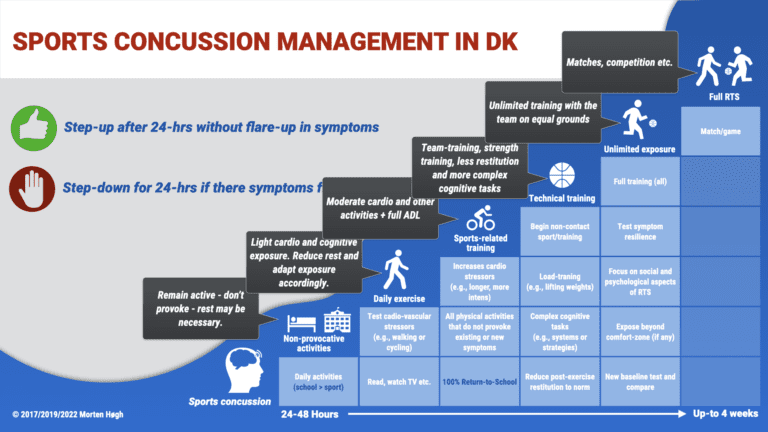Graduated return to sport protocol
A stepwise return to sport protocol is based around a six-stage timeline under the supervision of a medical practitioner. The intention is to gradually increase load and participation.
The following recommendations should be followed:
- After 24–48 hours of rest, symptom-limited activity can begin without significantly increased symptoms.
- The athlete should proceed to the next level if he/she can participate without a recurrence of concussion-related symptoms.
- Each step must take a minimum of 24 hours
- If any concussion-related symptoms occur during the stepwise approach, the athlete should drop back to the previous asymptomatic level and attempt to progress again after being free of concussion-related symptoms for a further 24-hour period at the lower level.
- The time frame for return to sport will vary between athletes
- Each step may take longer than 24 hours because of limitations in physical conditioning and recovery
Despite mandated policies from national governing bodies, it appears that some clubs and players may not be adhering to the minimum standards set out in the return to play guideline protocols. These protocols are vital for the longevity of athlete´s health and their time spend enjoying sport.
Always return to school and work before return to sport
Like return to play, considering how a concussed athlete returns to a full active ‘life’ after concussion or returns to learn or work is important for their well-being.
Like activity, it is important to take a phased and progressive approach to returning to education, ensuring success at each stage.
The coach plays an important role
It is not the coach’s responsibility to plan the return to sport process, but the coach can help the athlete by considering how to plan the practice sessions and integrate the athlete gradually both physically, mentally and socially. Learn more about the role of a coach here.
Athletes should feel that they fill the hole they left in the team during their injury. Check out some examples of support you can provide here (this link will open a PDF in a new tab).
Please accept marketing cookies to watch our videos.
SCENARIO
A player had in incident at yesterday’s practice, after which symptoms like dizziness and not feeling right was present – The athlete calls the coach and asks if it is OK to still join the practice today. If you were the coach what do you do?
A player has had a concussion and is returning to practice. The athlete has joined the first practice after the incident, but call you (the coach) after the practice, and tells you about symptoms like headache and nausea – What do you do?
Return to Sport Strategy
Does your sport have a return to sport strategy specific to your sport? CATTOnline have good examples and resources for establishing one. Check them out here.
Useful Resources
Please Note: These links will bring you to PDF documents on external websites.
- Activity Suggestions for Recovery Stages After Concussion (CanChild.ca)
- Concussion Resources for Coaches (CATTOnline.com)
- ABI Return – Children & Young People with Acquired Brain Injury – Guiding Their Return to Education (UKABIF.org)
- Return to Sport (CATTOnline.com)
- Return to School (CATTOnline.com)
- Return to Work (CATTOnline.com)
- Danmarks Idrætsforbund Hjernerystelser


